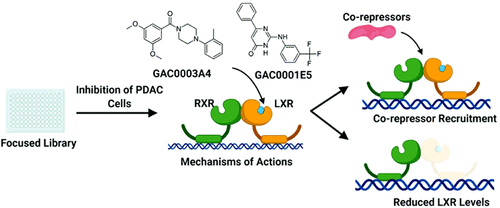当前位置:
X-MOL 学术
›
ACS Chem. Biol.
›
论文详情
Our official English website, www.x-mol.net, welcomes your feedback! (Note: you will need to create a separate account there.)
Screening of Focused Compound Library Targeting Liver X Receptors in Pancreatic Cancer Identified Ligands with Inverse Agonist and Degrader Activity
ACS Chemical Biology ( IF 4 ) Pub Date : 2020-10-19 , DOI: 10.1021/acschembio.0c00546 Husna Karaboga , Wentao Huang 1 , Shivangi Srivastava , Scott Widmann , Sridevi Addanki , Kasuni Thawalama Gamage , Zahra Mazhar , Jerry O. Ebalunode , James M. Briggs , Jan-Åke Gustafsson , Carly S. Filgueira 2 , Scott R. Gilbertson , Chin-Yo Lin
ACS Chemical Biology ( IF 4 ) Pub Date : 2020-10-19 , DOI: 10.1021/acschembio.0c00546 Husna Karaboga , Wentao Huang 1 , Shivangi Srivastava , Scott Widmann , Sridevi Addanki , Kasuni Thawalama Gamage , Zahra Mazhar , Jerry O. Ebalunode , James M. Briggs , Jan-Åke Gustafsson , Carly S. Filgueira 2 , Scott R. Gilbertson , Chin-Yo Lin
Affiliation

|
Pancreatic ductal adenocarcinoma (PDAC) is the predominant form of pancreatic cancer. PDACs harbor oncogenic mutations in the KRAS gene, and ongoing efforts to directly target its mutant protein product to inhibit tumor growth are a priority not only in pancreatic cancer but in other malignancies such as lung and colorectal cancers where KRAS is also commonly mutated. An alternative strategy to directly targeting KRAS is to identify and target druggable receptors involved in dysregulated cancer hallmarks downstream of KRAS dysregulation. Liver X receptors (LXRs) are members of the nuclear receptor family of ligand-modulated transcription factors and are involved in the regulation of genes which function in key cancer-related processes, including cholesterol transport, lipid and glucose metabolism, and inflammatory and immune responses. Modulation of LXRs via small molecule ligands has emerged as a promising approach for directly targeting tumor cells or the stromal and immune cells within the tumor microenvironment. We have previously shown that only one of the two LXR subtypes (LXRβ) is expressed in pancreatic cancer cells, and targeting LXR with available synthetic ligands blocked the proliferation of PDAC cells and tumor formation. In a screen of a focused library of drug-like small molecules predicted to dock in the ligand-binding pocket of LXRβ, we identified two novel LXR ligands with more potent antitumor activity than current LXR agonists used in our published studies. Characterization of the two lead compounds (GAC0001E5 and GAC0003A4) indicates that they function as LXR inverse agonists which inhibit their transcriptional activity. Prolonged treatments with novel ligands further revealed their function as LXR “degraders” which significantly reduced LXR protein levels in all three PDAC cell lines tested. These findings support the utility of these novel inhibitors in basic research on ligand design, allosteric mechanisms, and LXR functions and their potential application as treatments for advanced pancreatic cancer and other recalcitrant malignancies.
中文翻译:

靶向肝X受体的聚焦化合物文库的筛选在具有逆激动剂和降解活性的胰腺癌识别配体中
胰腺导管腺癌(PDAC)是胰腺癌的主要形式。PDAC的窝藏在致癌突变KRAS基因,以及不断努力其突变蛋白产物直接靶向抑制肿瘤生长是一个优先不仅在胰腺癌,但在其他恶性肿瘤如肺癌和结肠直肠癌,其中KRAS通常也是突变的。直接靶向KRAS的另一种策略是鉴定和靶向参与KRAS失调下游癌症标志失调的可药用受体。肝X受体(LXR)是配体调节的转录因子核受体家族的成员,参与对在关键的癌症相关过程中起作用的基因的调节,这些过程包括胆固醇转运,脂质和葡萄糖代谢以及炎症和免疫反应。通过小分子配体对LXR的调节已成为直接靶向肿瘤细胞或肿瘤微环境中的基质细胞和免疫细胞的有前途的方法。我们先前已经证明,两种LXR亚型(LXRβ)中只有一种在胰腺癌细胞中表达,并以可用的合成配体靶向LXR可以阻止PDAC细胞的增殖和肿瘤形成。在预计将停靠在LXRβ配体结合口袋中的类药物小分子聚焦文库的屏幕中,我们鉴定了两个新的LXR配体,其比我们已发表的研究中使用的当前LXR激动剂具有更强的抗肿瘤活性。两种前导化合物(GAC0001E5和GAC0003A4)的表征表明它们起LXR反向激动剂的作用,抑制了它们的转录活性。新型配体的长期治疗进一步揭示了它们作为LXR“降解剂”的功能,该功能可显着降低所有测试的三种PDAC细胞系中的LXR蛋白水平。这些发现支持了这些新型抑制剂在配体设计,变构机理,
更新日期:2020-11-21
中文翻译:

靶向肝X受体的聚焦化合物文库的筛选在具有逆激动剂和降解活性的胰腺癌识别配体中
胰腺导管腺癌(PDAC)是胰腺癌的主要形式。PDAC的窝藏在致癌突变KRAS基因,以及不断努力其突变蛋白产物直接靶向抑制肿瘤生长是一个优先不仅在胰腺癌,但在其他恶性肿瘤如肺癌和结肠直肠癌,其中KRAS通常也是突变的。直接靶向KRAS的另一种策略是鉴定和靶向参与KRAS失调下游癌症标志失调的可药用受体。肝X受体(LXR)是配体调节的转录因子核受体家族的成员,参与对在关键的癌症相关过程中起作用的基因的调节,这些过程包括胆固醇转运,脂质和葡萄糖代谢以及炎症和免疫反应。通过小分子配体对LXR的调节已成为直接靶向肿瘤细胞或肿瘤微环境中的基质细胞和免疫细胞的有前途的方法。我们先前已经证明,两种LXR亚型(LXRβ)中只有一种在胰腺癌细胞中表达,并以可用的合成配体靶向LXR可以阻止PDAC细胞的增殖和肿瘤形成。在预计将停靠在LXRβ配体结合口袋中的类药物小分子聚焦文库的屏幕中,我们鉴定了两个新的LXR配体,其比我们已发表的研究中使用的当前LXR激动剂具有更强的抗肿瘤活性。两种前导化合物(GAC0001E5和GAC0003A4)的表征表明它们起LXR反向激动剂的作用,抑制了它们的转录活性。新型配体的长期治疗进一步揭示了它们作为LXR“降解剂”的功能,该功能可显着降低所有测试的三种PDAC细胞系中的LXR蛋白水平。这些发现支持了这些新型抑制剂在配体设计,变构机理,



























 京公网安备 11010802027423号
京公网安备 11010802027423号